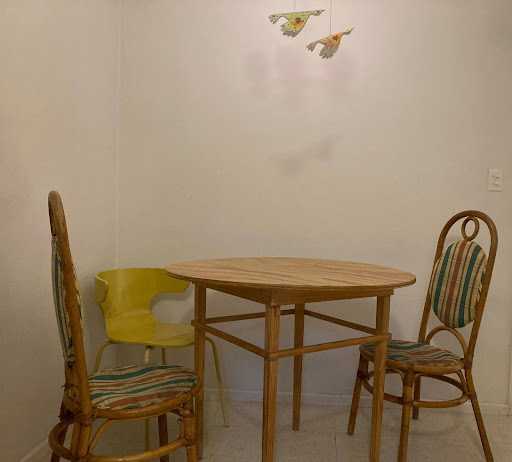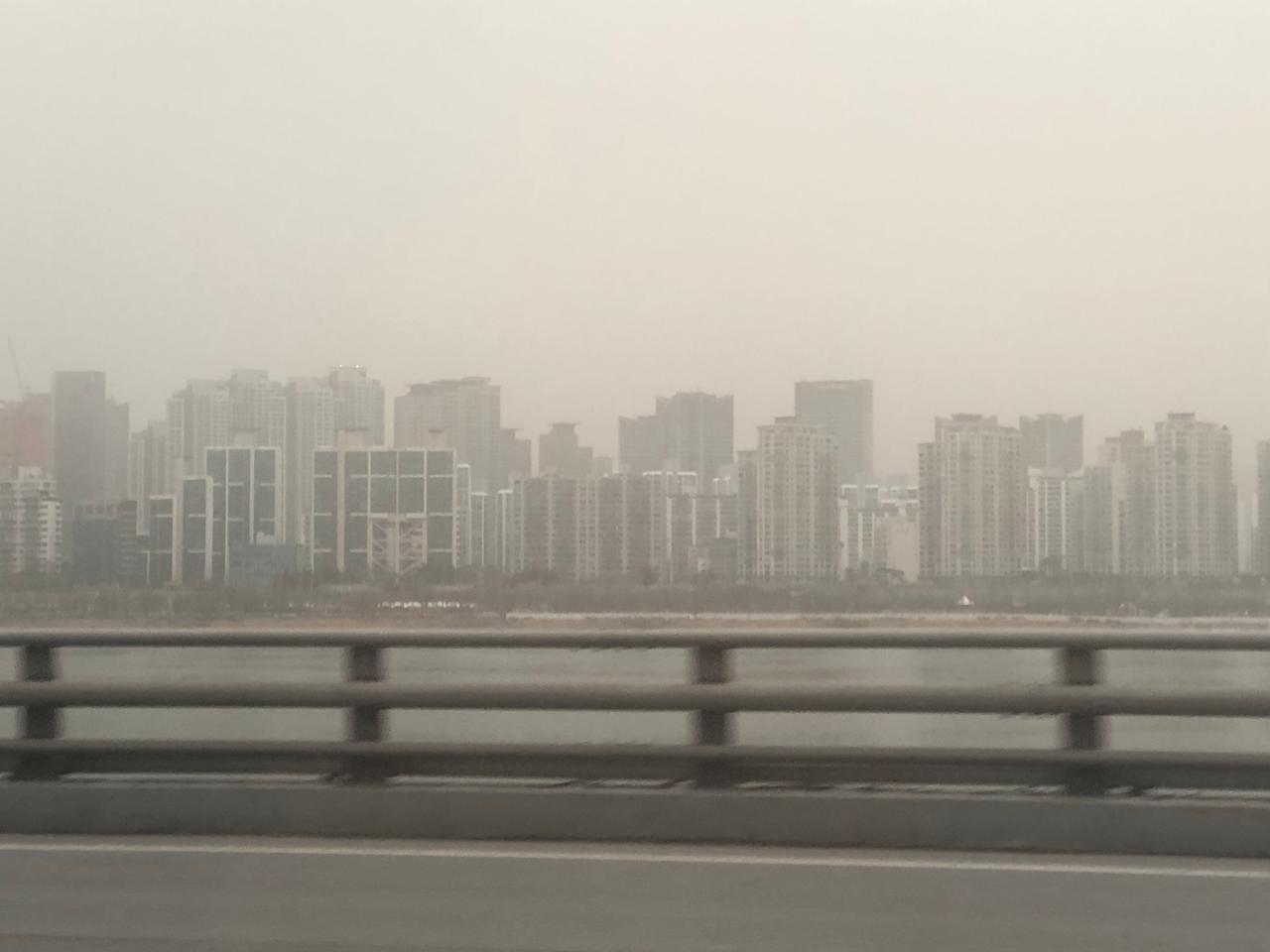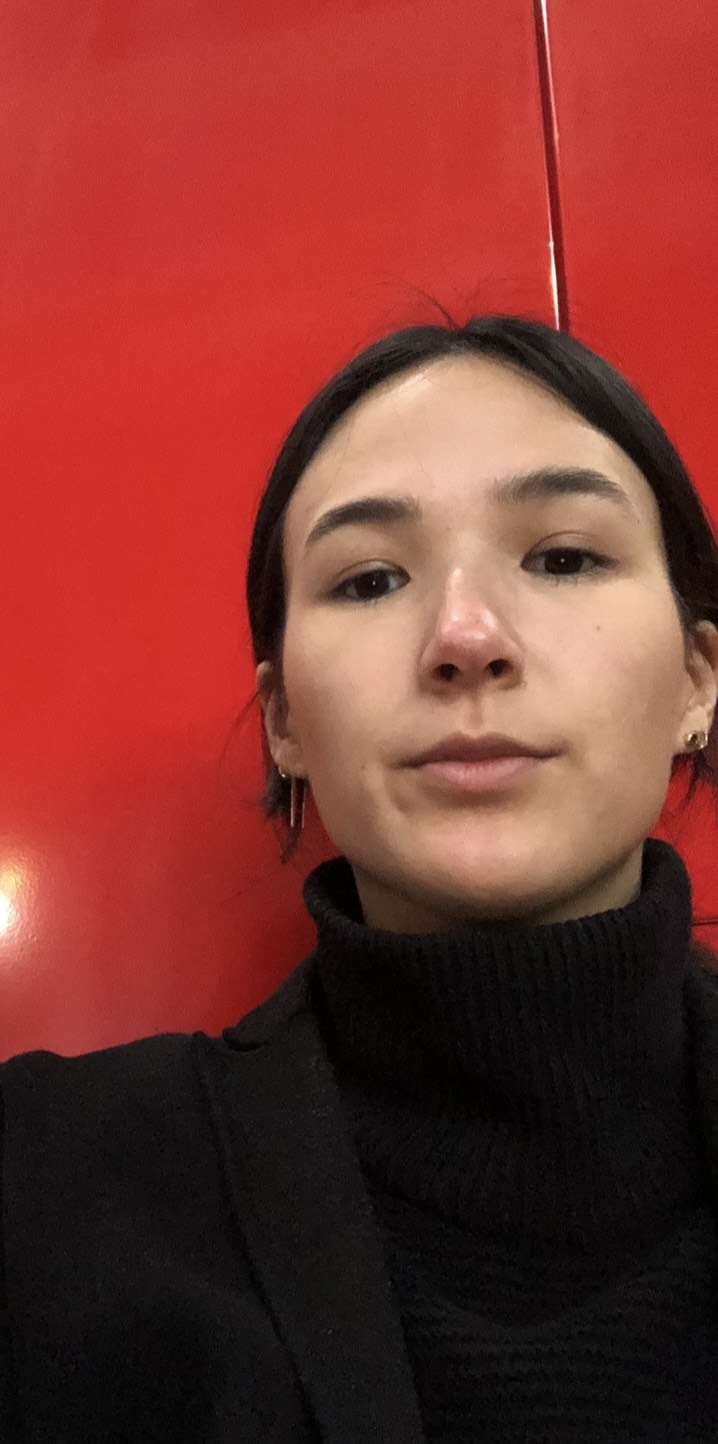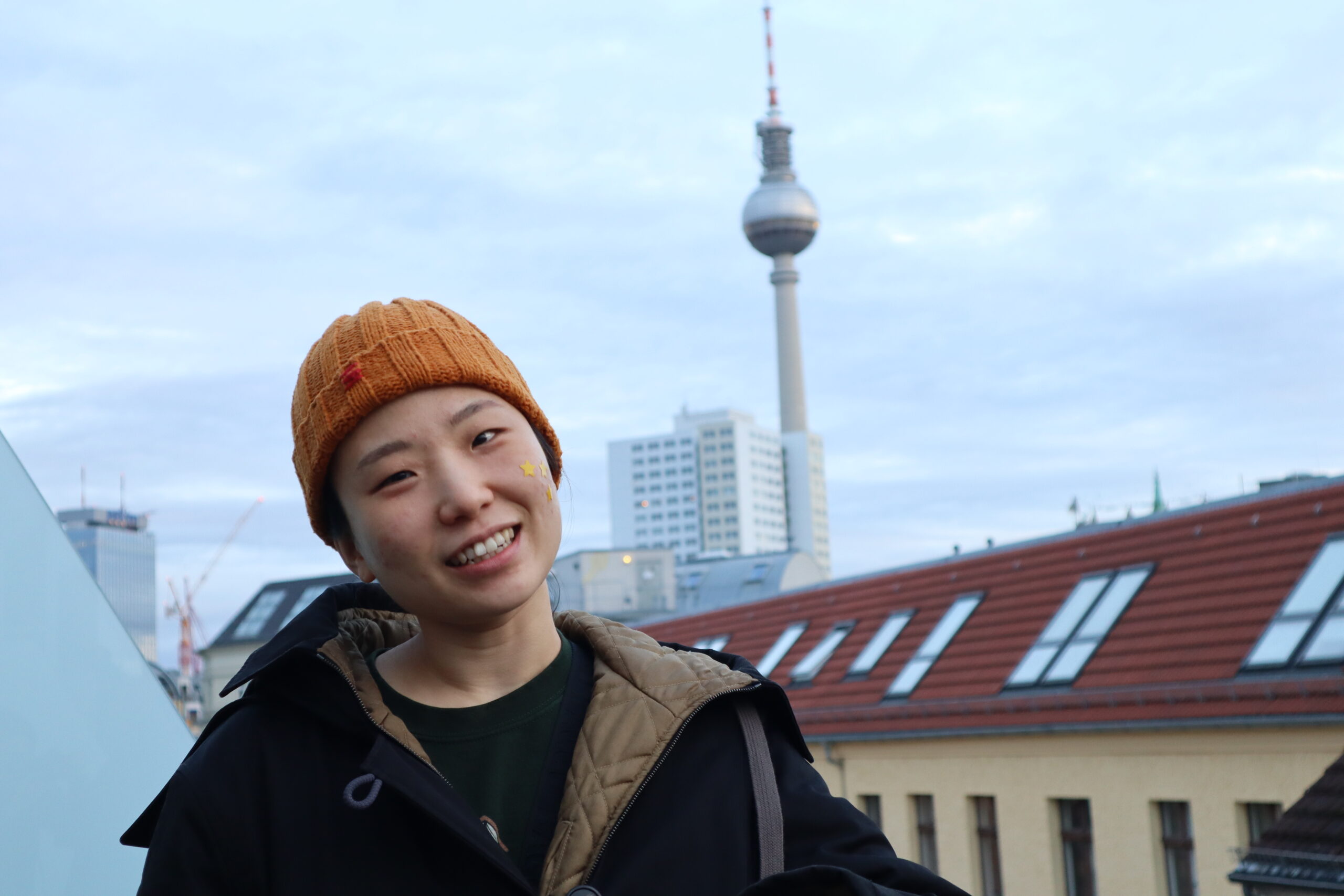Between Delivery: Letter Threads After the Theresa Hak Kyung Cha Archive (Part I)
May 12, 2025

This series of letters emerged from Ju Ly Ban’s work as a Fellow for Lost & Found: The CUNY Poetics Document Initiative from the Center for the Humanities at the CUNY Graduate Center, grounded in archival engagement with the work and life of Theresa Hak Kyung Cha. Attuned to the fragments of her presence in the archive, the letters imagine otherwise by rethinking how she has been approached, interpreted, and held in relation.
Introduction

A small table in the kitchen of the New York apartment where Cici was staying. In May 2024, Cici, Isabelle, and I gathered around this table, sharing stories about Theresa—stories that would later continue in our email exchanges. Photograph by Cici Wu.
When Ju Ly Ban first arrived at the Berkeley Art Museum and Pacific Film Archive (BAMPFA), Theresa’s letters spoke to her most. Her correspondences (letters to editors, friends, and fellow artists) seemed to breathe, their voices rippling across time. As she read, Ju Ly felt drawn into their presence, as if sitting beside Theresa and those she wrote to. Each page felt alive in her hands, grounding her in moments that felt at once past and present.
The letters that follow continue this conversation. They are part of an exchange among Ju Ly Ban, Isabelle Utzinger-Son, and Cici Wu. For the past two years, the three friends have written to one another about Theresa, her life, her art, and the traces of both they have found within and beyond the archive. Composed in New York, London, Hong Kong, and in the in-between spaces of planes and trains, these letters carry their thoughts of each other and of Theresa, whose work first brought them together. They offer these words in the hope that they might reach you, and that their voices, like hers, might linger in your present as hers continues to shape theirs.
Part I
![A 1921 Pashishi 4-6-2 steam locomotive, built in Japan for the Korean Government Railway (Sentetsu).The locomotive, numbered 923, represents Japan’s shift to domestic railway engineering and its expansion of rail networks throughout its colonies, including Korea and Manchuria, as part of its broader imperial ambitions in the early 20th century. World History Commons, https://worldhistorycommons.org/southern-manchuria-railway-1906-1945 [accessed March 1, 2025]](https://centerforthehumanities.org/wp-content/uploads/2025/05/Southern-Manchuria-Railway-1906-1945.jpeg)
A 1921 Pashishi 4-6-2 steam locomotive, built in Japan for the Korean Government Railway (Sentetsu). The locomotive, numbered 923, represents Japan’s shift to domestic railway engineering and its expansion of rail networks throughout its colonies, including Korea and Manchuria, as part of its broader imperial ambitions in the early 20th century. World History Commons, [accessed March 1, 2025]
Letter #1
Dear Cici and Isabelle,
I hope this letter reaches you in your own rhythms, in whatever time zones hold you now. It’s five in the afternoon here in East Harlem. I’m sitting at my desk, writing to you, wondering: Cici, are you still at 47 Canal? Isabelle, is it nearing your bedtime?
I’m grateful that these letters bring us together, that Theresa draws us into a shared space despite the many differences in our lives. Even now, our thoughts and tomorrow’s to-do lists might be worlds apart. Yet, there’s this moment. a connection I call “click.” For me, that click began with Theresa’s work. A small, quiet sound. An almost imperceptible gesture that paused me. It made me reread Dictee. It led me into archives in New York and Berkeley. Click. I still find myself lingering in her fragments, letting them hold me in their silences. Click. How would you describe such intimacy?
For this first letter, I want to return to the piece that sparked this connection: White Dust From Mongolia, Theresa’s unfinished novel and short film. Cici, you first told me about it during your time at the Asia Art Archive in America, and later, I encountered it at the Berkeley Art Museum and Pacific Film Archive, where I met Isabelle. I keep turning over questions about this work—about how it moves us, how we might share it—and I’m eager to hear your thoughts.
My introduction to White Dust was through Exilee and Temps Morts (2022). Five pages of storyboards and film stills lit my imagination. But it was Theresa’s “Statement of Plans,” the one you shared with us, Cici, that truly stayed with me. In it, she writes:
“The main character in the story is a young woman, Korean by birth and living in China. An unforeseen experience occurs during her young adulthood which causes her to lose all memory, and lose at the same time her capacity for speech.”
Through this, Korea and China come alive, shaped by history. Theresa roots the work in a specific era—the Japanese occupation of Korea (1909–1945)—a time when countless lives were displaced, their movements reshaping borders and belonging. Though Theresa herself never lived through this time, it was her mother’s reality, a history she sought to reimagine through her art.
The film or novel was never finished, yet its fragments remain, and I imagine it through her writings. Dictee, the book she published after returning from Korea, feels like a glimpse into the cinematic vision she might have realized. Her words reach toward lives she could not live, toward landscapes that held her family’s past.
Reading Dictee aloud, I feel her rhythm, her breath, her pauses. I see the windy fields of Yongjeong, Manchuria. The train her mother boarded for her teaching job. The expectant chatter of children waiting to meet her. Her frail body. Her bent hands. Her voice, lifting into song. And the Japanese flag snapping in the wind.
I’ll keep tracing the threads between Dictee and the film she dreamed of making, piecing together what might have been. But I’m most excited to hear your thoughts—how her work moves through you, what it asks of you, how you might share it with others.
Hugs,
July

Apartment buildings in Gangnam, taken by Isabelle, March 29th 2024
Letter #2
Dear July, dear Cici,
I haven’t written a letter in some time, let alone one that wasn’t a letter of apology, or a letter that accused someone of something. I also cannot recall the last time I wrote a letter that I actually sent––there were times in my life, when the act of addressing someone in theory seemed like the only way to resolve an unfixable problem. The letters I wrote and did send never seemed to fix anything at all, nevertheless, writing them fixed some aspect of myself onto the page.
July, you mentioned that you clicked with Theresa at some point. Hearing a sound, or perhaps seeing a spark with your inner eye––a signal of sorts, a moment in time, which marked your entrance into the world and work of Cha. For what you speak sounds to me like a moment of reconnaissance, of meeting yourself in the trace of someone else’s mind, a moment of irreversible immersion into a realm from which you can never return.
I too have felt something akin to that, however, I have often found myself getting lost there. It is a very peculiar sensation, feeling lost and familiar with your surroundings at the same time. Perhaps, this explains my first encounter with White Dust, an encounter which, in hindsight, occurred before I knew of its existence.
Three, maybe four years ago, the southern winds were particularly strong, carrying Saharan dust to London and turning the city’s gloomy grey skies into a dystopian yellow. I was in Regents Park, drawing circles in the thin surface of dust covering the bench I was sitting on, and I thought to myself that perhaps, this is the closest I will ever come to inhabiting two places at once. The familiarity of my surroundings, covered in a thin blanket of elsewhere.
My second, unknown, encounter with White Dust was last February, when I travelled to Korea with my mother for the first time in over ten years. It was supposed to be a big family reunion––we hadn’t been together in one place since my grandparents passed away. My mother’s siblings, their children, my mother and myself met at my grandparent’s grave, laying out foods on the altar, each generation bowing to their ancestors. The following day, my uncle, my mother’s eldest brother, was declared brain dead after suffering a stroke. We were on the road when we got the news, tracing the southern bank of the Han river.
I remember seeing the tops of skyscrapers disappearing in the smog. Moments earlier from behind the wheel, my mother’s youngest brother made a remark about the bad air quality that day––Dust from China, he said in a tone that I couldn’t help but perceive as disparaging.
I think of Cha and her brother James, arriving in Seoul to film White Dust, only to find the contours of their childhood forming unfamiliar expressions.
I think that the unrequited desire to return to an ideal of home, of place, can haunt one’s perception of the world in unforeseen ways. Returning is a longing to belong, but it is also nothing but a journey without an arrival.
I think that, with White Dust, Cha intended to capture a place specifically elsewhere. A place where arriving feels the same as leaving.
I think that White Dust is about the longing to belong in a world that has rendered itself unrecognisable.
How to tell the story of such a return?
Jacqueline Rose once spoke on the work of Sylvia Plath, describing her poems as performing “A leap of imagination that would connect to that history which she precisely did not live.” I believe that Cha’s return to Seoul to film––to imagine––the life of a woman who returns to a place whose history she cannot remember living, is akin to such a leap of imagination.
Perhaps that is why Cha wrote White Dust in two voices, a voice that speaks, in the absence of memory about the unbearable weight of memory, and another that has to bear the weight of language, of signification, of the impossible task of making memory, the ineffable, effable.
I send you love.
Isabelle

Apartment buildings in Gangnam, taken by Isabelle, March 29th 2024
Letter #3
Dear July,
Dear Isabelle,
It’s hard to write on the airplane.
Typing this letter now from a hotel in Shanghai, I am finally settled after a long flight with multiple transits. The air is very humid in this summer time. My body and mind are still in a state of suspicious murkiness, accompanied by a dull ache in my neck. When I press my hand to my forehead and close my eyes, things feel somehow clearer.
I sometimes find myself gazing at empty spaces – a hotel room, terminal building through airport windows – wondering,
“What is there to separate us?”
The touching passage from White Dust still resonates now:
All the elements are historical to lessen the physical geographical distance as well as the psychological distance of the Asian people from other ethnic cultures. The causes for the Korean War, and the reasons for the division of Korea into North and South, and the perpetuating conditions of Cold War will contribute to the understanding of Korea and Asia as whole cultures, not merely state their economic and political status as nations.
As you noted, we shared a cosmic click—encountering each other through the White Dust. To me, White Dust has become like an old friend, whose mysterious hand still guides me on a journey of discovery. When I speak of White Dust, it could mean White Dust From Mongolia, at the same time, it could also be Upon Leaving the White Dust.
It is hard to pin down what exactly the first cause was that had drawn me to this unfinished piece. While Cha sought to ground the work in rationality and historicity, recreating the past through critical fabulation – “a young woman, Korean by birth and living in China. An unforeseen experience occurs during her young adulthood which causes her to lose all memory, and lose at the same time her capacity for speech” – it was perhaps simply the two words “White” and “Dust” that captivated me most.
Maybe I wanted to recall and echo the snow of Manchuria.
This trip coincidentally led me to my own family histories. I started imagining the stories of my great grandmother (1901-1988) and great grandfather (1886-1965), both were born in Northeast China – the very region where Cha intended to conduct her research for White Dust from Mongolia.
Isabelle, you spoke of voices in Cha’s work and your experience of returning to Korea with your mother. Could you share more about your insights on “voice” and “verbal language” from that journey?
I’m grateful for July’s transcription of Cha’s 1982 Montreal airport letter. I read it when I was at JFK. July, the moment you told me you found “Time” in her letter, I almost cried. It reminded me of your earlier observation that Cha didn’t seem to understand time as moving forward in her work. I am also thankful to Isabelle for sharing a photo of buildings in Seoul from her trip, referencing what Cha described as “tombstones” in the letter, and how she looked at centers differently, breaking down the boundaries of death, life and nation.
As we descend, the trees are bright red. I enter a different time.
My thoughts about our book: how can we create a book that not only tells readers about us and Cha, but somehow reads the readers in return? How can we turn loss of memory into a path of remembering? Transform scars of dislocations into cosmic connections? Against ruptures and erasures, we move from History toward narrating experiences of time that belong to those we’ve forgotten we loved.
Cici


